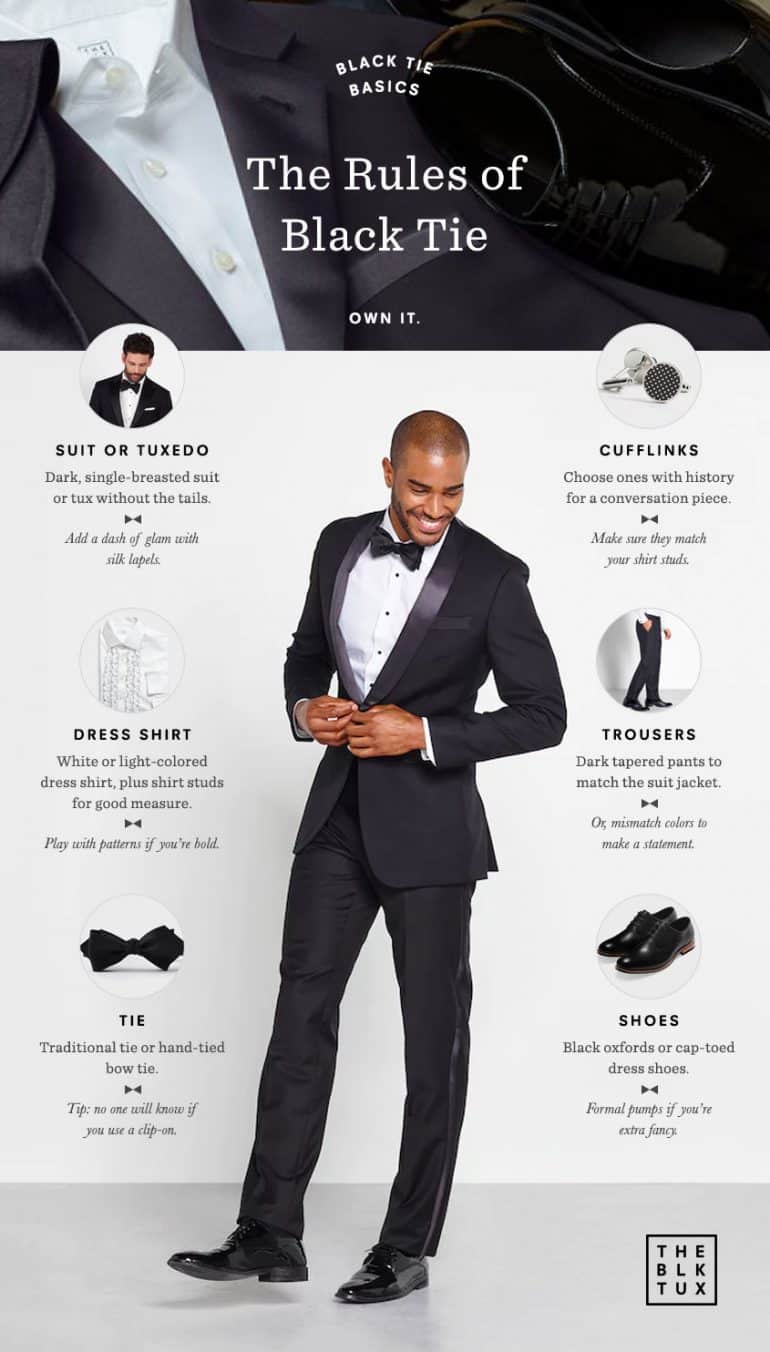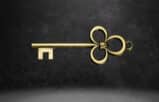I’m not gonna lie: You look good. You’re walking through the lobby on your way to tonight’s gala, checking your cufflinks like a boss, your bow tie ever so slightly rakish. Which is all very good because though you’re always making an impression, formal events are an opportunity to put your sartorial savoir-faire on display.
You are a master of the following important rules for black tie and it shows.
Does Black Tie Always Mean Tuxedo?
Yes, you savage. It always means tuxedo. Except, OK, not always. Usually, the invitation will tell you.
If the invitation says black tie, that means wear a really nice suit, preferably a tux. Maybe you don’t own a tux. Maybe you own a killer single-breasted dark suit — which is fine. It wouldn’t fly on “The Crown” but for you it’s OK.
If the invitation says formal, then wear a tuxedo. Don’t own one? Rent.
If the invitation says formal, but “black tie optional,” then you have an opportunity to show off that killer burgundy dinner jacket with the black lapels you’ve been dying to wear. Just remember, when you wear a burgundy dinner jacket you’re required to walk around with a snifter of brandy and tell everybody what they don’t know about jazz.
If the invitation calls for “tropical black tie,” don’t run out and buy a Hawaiian shirt tux. Weirdo. It means a white dinner jacket over black trousers. All of your accessories should be black. And if you’re looking at that one tuxedo jacket with the tails, just stop. You’re not a bird.
Wondering What Makes a Tuxedo a Step Above a Suit?
It’s way simpler than you think. Tuxedoes have satin highlights. That’s it.
The lapels and the pocket trim are satin, and there’s a satin stripe running up the outside of the trouser legs. All the other stuff is décor. Like the cummerbund, which dates to the British occupation of India, and there’s a long Wikipedia entry explaining how they started out as a sash, but I won’t bother you with that because — they started out as a sash. You can also wear a waistcoat.
Components and Accoutrements
In addition to your impeccable taste, formal events also allow you to display your admirable attention to detail.
The Dress Shirt
White or light-colored dress shirt, plus shirt studs for good measure.
Or, play with patterns if you’re bold.
Your tux is gonna be just like every other tux at the party. You could stand out by getting a solid red tux with bright gold lapels, sure, but you’d be standing out for the wrong reasons. The tux is a fashion field leveler. It’s meant to make all the guys look British. You can stand out with your shirt and all the glistening accouterments that go along with it.
The collar. You have choices. There are tall spread collars, cutaways, point collars, button-downs and club collars. I’m a fan of the small spread collar for a formal shirt. It looks great with a tie or a cravat, but it’s just different enough to add a dash of panache. And look, a dash is all you want. Too much panache makes you gauche and that’s gross. If you want to really look cool, wear a mandarin collar with a unique pin holding it together. It’s a little rock ‘n’ roll.
The fabric. Most formal shirts are plain satin cloth or vertically ribbed silk shirts. But you can step away from tradition here. First, the fabric doesn’t have to be white. But be careful. Not everything goes with black, so deviate cautiously. A very light blue or a very light pastel color is probably OK, depending on the event and the level of snoot required. Then there’s the weave or texture of the shirt. Poplin is the most common weave, and it’s nice. But if you want to wear a shirt that has fascinating detail, shoot for a finer weave or an uncommon one like Pinpoint Oxford, which looks like a finer Oxford basket weave but feels like satin. Herringbone’s opposing chevron weave is a classic deviation, along with Royal Oxford.
The buttons. The top four visible buttons of a formal shirt are removable so you can replace them with decorative studs. Typically, the studs match your cufflinks. But you’re not typical and this is one of those details that rewards close quarters. From a few feet away, your shirt studs might look like any old ebony colored buttons but close up, maybe they’re carved to look like the surface of the moon. Or maybe they’re skulls (a personal favorite).
The cuffs. Finally, your cuffs should be French cuffs so you can use cufflinks. But, of course, there are options. Like rounded French cuffs, which are just French cuffs with a lovely rounded edge. Or convertible square cuffs, which are handy if you lose your cufflinks. If you’re into Sprezzatura, you can forgo cufflinks altogether and let your unbuttoned cuffs droop out of your sleeve like a rock star.
The Tie
Traditional tie or hand-tied bow tie.
Some may tell you otherwise, but everyone will know if you use a clip-on. You’re a grown man. Don’t wear a clip-on.
If you’re wearing a tux, wear a bow tie. If you’re wearing a suit, you can get away with a regular tie. But those aren’t your only options. (Surprised?) Don’t be afraid to try out a cravat or an ascot. String ties are fine if you’re Colonel Sanders or attending a ball in Texas in 1843, but otherwise, no.
Wildly colored bow ties are a sensitive area. They offer an opportunity for you to show off your style but they also offer you an opportunity to show off your style. If you’re using a crazy bow tie to show off your personal style, make sure that you actually have a personal style. Unsure? DON’T.
There are two oddball ties of which I’m a huge fan: the continental and the continental. For some reason, there are two versions. One is a simple strip of black satin that wraps just under the collar, forming a plain winged delta against the shirt. Then there is the wingless version. Imagine the knot of a long necktie without the necktie. If you watch Gotham, you’ve seen Robin Lord Taylor sporting one of these while playing “Penguin.”
The Cufflinks
Choose ones with history for a conversation piece.
Make sure they match your shirt studs.
For formal functions, you better link those cuffs, pal, and you better link them with style. Should your cufflinks match your shirt studs? Absolutely. Unless maybe not. Look, style is a weird thing. It bends not only to immediate trends but to personal eccentricities. You can never go wrong with classics: a gold monkey knot, a plain silver square, a simple lacquer circle.
But personal style sometimes means fastening your finials with oddball trinkets. I believe your cufflinks are where your personal savoir-faire can really sparkle: ironic links made from German scrabble tiles; silver gavels because you’re a lawyer, dammit; Mexican Day of the Dead skulls. I’m a huge fan of mismatched cufflinks. Mostly because I can only ever find one of each so I’ve decided that’s a style.
The Trousers
Dark tapered pants to match the suit jacket.
Or, mismatch colors to make a statement.
Keep them dark and tapered. Make sure they match your jacket. Don’t go crazy. Nobody notices pants. Unless you’re not wearing any, which is a bold fashion statement I cannot in good conscience recommend. You can mix and match colors if you’re the kind of guy who can mix and match colors. Not all of us can get away with it. Some guys can get away with a white jacket and lime green pants. Other guys wear the same outfit and they look like a sideshow got drunk. If you’re the kind of guy who can get away with this you already know it and I can’t tell you anything because you’re a fashionista and you’re above reproach. If you’re wondering if you can get away with orange pants, just no.
What About Shoes?
Black Oxfords or cap-toed dress shoes.
Formal pumps if you’re extra fancy.
There are only two shoes you may wear with a tuxedo:
- Patent leather loafers
- Velvet slippers
Now, before you get all trollish and write me a letter about velvet slippers and about how you’re not an elite snob and maybe I should read a book or something, I’d just like to point out that you’re wrong. Fine. They’re supposed to be suede, which is made from leather, where velvet is made from silk (unless you’re a hobo, in which case they’re made from nylon). But velvet slippers are making headway. They are scoring entreaties onto the barking dogs of the evening set. Try them.
But if you’re afraid of nappy, fuzzy comfort, wear a black mirror patent leather loafer or an Oxford.
The third shoe you can wear with formal attire can only be worn by the ultra stylish or by my brother, Flowers, who pulls this off with extraordinary panache: patent leather sneakers with a bright red sole. I don’t know how he does it, but the fashion police haven’t caught him yet.
Illustration ©iStockPhoto.com
You Might Also Like:
- 21st Century Table Etiquette for Professionals
- Avoiding Dining Table Faux Pas
- The Secret Science of Mingling
Subscribe to Attorney at Work
Get really good ideas every day for your law practice: Subscribe to the Daily Dispatch (it’s free). Follow us on Twitter @attnyatwork.























